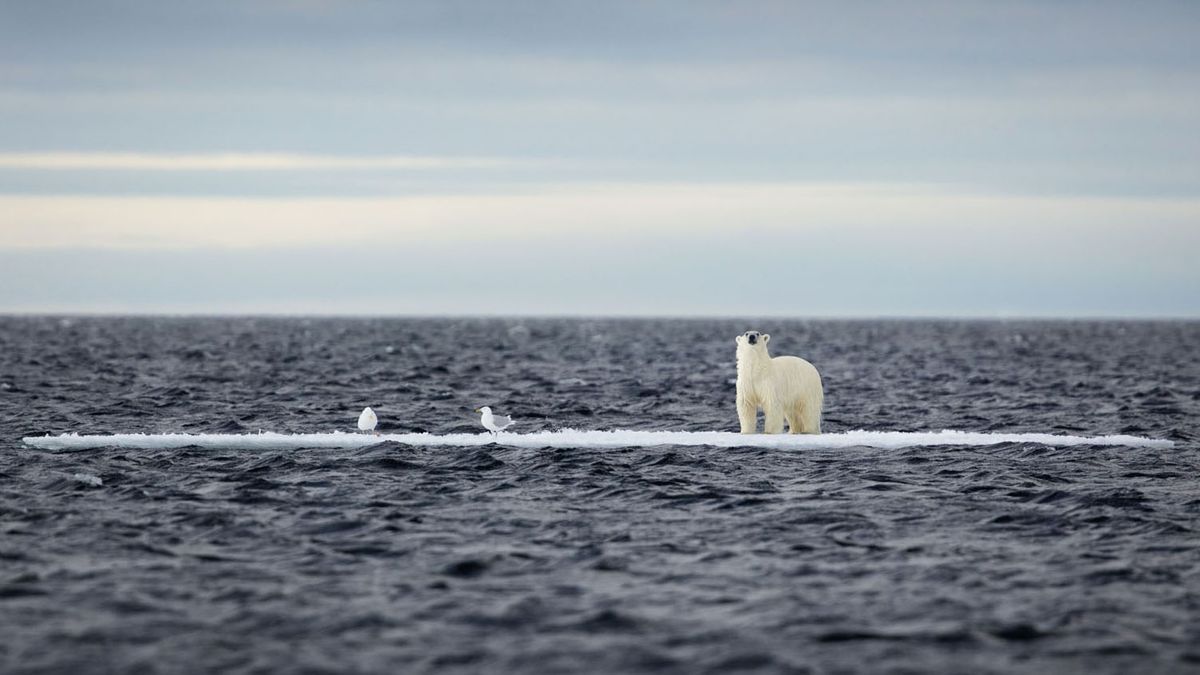
A tear-jerking depiction of a polar bear clinging to a small ice floe in the Arctic Ocean is one of the highlights of the Royal Photographic Society’s (RPS) Science Photographer of the Year 2020 awards.
As with many of the winning images, the polar bear photo – ‘On Thin Ice’ by Sue Flood FRPS – paints a poignant picture of the current climate emergency facing the planet.
In the last Science Photographer competition of the year, the RPS introduced a climate change category, which Flood won with another of her photos taken in the Arctic: ‘North Pole Underwater’.
A total of four winners of the competition will be displayed along with seventy-five selected images as part of the digital Manchester Science Festival – taking place February 12-21 – hosted by the city’s Science and Industry Museum. The online exhibition will run until May 2 after the festival.
The four winners and some selected images can be seen below.

Science Photographer of the Year (General Science category)
‘Orthophoto or SS Thistlegorm’ by Simon Brown
The wreck of SS Thistlegorm, a ship that sank in the Red Sea in 1941, in an image derived from 15,005 frames. Each wreck was modified to give a ‘straight down’ image before being tagged with GPS data and merged with the others. ship is a well known recreational dive site (divers bottom right), slowly becoming part of the local coral reef. “

Young Science Photographer of the Year (General Science category)
Rainbow Shadow Selfie by Katy Appleton
“Sunlight casts a spectrum on a wall after passing through a prism. The photographer cast her own shadow on the wall to make the spectrum shine more clearly.”

Science Photographer of the Year (Climate Change Category)
North Pole Underwater by Sue Flood
“A signpost with the geographic North Pole at 90 degrees latitude, placed on sea ice that is largely covered with water. Each year, the ice cover over the Arctic is decreasing, a direct result of changing global climates.”

Young Science Photographer of the Year (climate change category)
‘Apollo’s Emissary’ by Raymond Zhang
“A Concentrated Solar Power Plant (CSP) in China. 12,000 mirrors reflect sunlight to a central tower where the sodium nitrate salt heats. This goes to a heat exchanger and makes steam to drive generator turbines. The thermal inertia is such that the station can operate the entire working at night, which saves up to 350,000 tons of CO2 emissions per year. “

Selected image
‘Turing Patterns – BZ Response’ by Dr. David Maitland FRPS
“Hypnotic patterns formed by a Belousov-Zhabotinsky (BZ) reaction in a petri dish. Drops of one chemical are added to another in the bowl. The drops appear to radiate concentric rings and spirals as waves of chemical concentrations pass through the bowl. Petri dish. The math behind this was described by Alan Turing. “

Selected image
Giants on the move by Rasmus Degnbol / REDUX Pictures
“A 78 meter blade for an offshore wind turbine seen crossing a roundabout in the town of Tarp, Denmark.”

Selected image
‘Lo Hueco’ by Nuno Perestrelo
Scientists carefully remove rock from the fossilized vertebrae of a dinosaur discovered in the Lo Hueco area near Cuenca, Spain. A massive Upper Cretaceous deposit (100-66 million years ago) discovered by construction workers in 2007 has revealed more than 10,000 fossil copies produced. “

Selected image
“Synlight” Experiment “by Christian Lünig
“Some of the 149 xenon arc lamps that make up the ‘Synlight’ experiment. This provides a light intensity that is 10,000 times greater than the incident radiation from the sun, and is used in experiments to make fuels such as hydrogen from water.”

Selected image
‘The Net That Strangles the Ocean’ by Rafael Fernandez
“A sperm whale (Physeter macrocephalus) entangled in a discarded fishing net. Discarded fishing equipment, known as ghost gear, accounts for 640,000 tons, or 10%, of all marine litter. Ghost nets entangle a wide variety of marine life from whales and sharks to turtles , fish and sea birds. “

Selected image
The dead river by Abdul Momin
Cattle are led across a sandbar to search for water and vegetation. This photo was taken in Gaibandha, Bangladesh, where the changing course of the Brahmaputra River has left many villages miles from fresh water for their herds.

Selected image
‘Cygnus Pressurized Module’ by Enrico Sacchetti
“Interior view of a Cygnus spacecraft, a replaceable unmanned cargo spacecraft used to transport supplies to the International Space Station orbiting Earth. The cargo module has a capacity of 2,000 kg.”

Selected image
‘Dinosaur Bone’ By Norm Barker ASIS FRPS
“Viewed through a microscope, a polished slice through a fossilized dinosaur bone reveals multiple colors due to the deposited minerals. The different colors come from the changing mineral content as the fossil formed and do not reflect the underlying structure of the bone. This image includes a field. of 1.2 mm. “

Selected image
‘Spherical Aberration’ By Richard Germain
“A simple spherical lens placed in a patterned tube distorts the light passing through it. The distortion is greater towards the edge of the lens due to spherical aberration, the inability of all light to be brought to a common focus point. . “
“This year’s Science Photographer of the Year is more relevant than ever before to document how science and climate change affect our lives,” said Dr. Michael Pritchard, Director of Education and Public Affairs at the RPS.
“The selected images are striking and will make us think more about the world around us.”
To support schools and young people, the RPS has set up a bank with educational materials in collaboration with PhotoPedagogy. In addition, the competition was supported by Olympus, which presented camera awards to the winners in the under-18 categories.
Read more:
Best camera for nature photography
Best camera for landscape photography
Best lenses for landscape
Tips for landscape photography